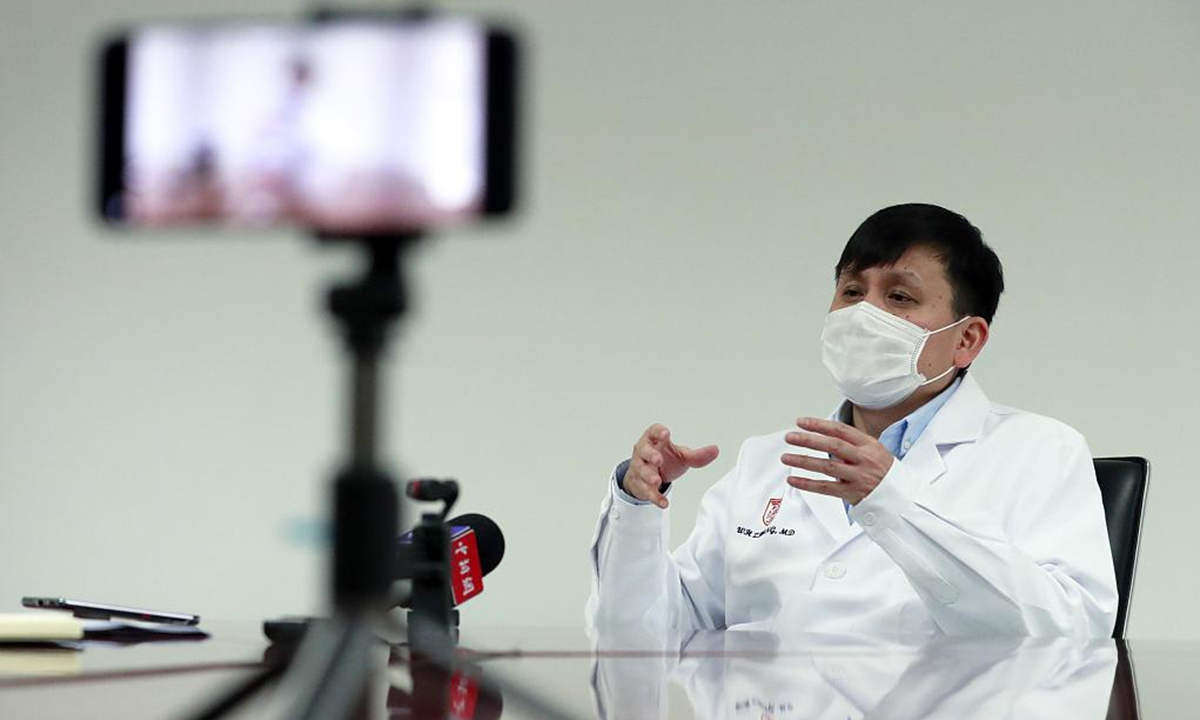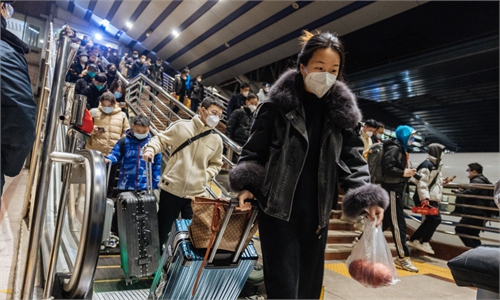‘Zhang Wenhong phenomenon’ shows inclusiveness of China’s public opinion sphere; policymaking based on science helps nation firmly hold strategic initiative of epidemic fight

Zhang Wenhong. Photo: VCG
On Friday, China released the 10th edition of the COVID-19 prevention and control protocol. Moreover, starting from Sunday, the country downgraded the management of COVID-19 from Class A to Class B and lifted quarantine requirements for inbound travelers. The policy shift indicates that the focus of the country's anti-COVID efforts has shifted from preventing infection to protecting people's health and preventing severe cases. At the same time, the society is gradually returning to normal.Strategic initiative
China has always firmly held the strategic initiative in the epidemic fight. Its COVID-19 response measures can be characterized as scientific, precise and active. With strategic determination and tactic flexibility complementing each other, specific prevention and control measures have been constantly optimized and adjusted in light of the evolving situation across the three years of the fight against the pandemic.
During China's three-year fight against COVID-19, the country's prevention and control measures have always been based on scientific research and evaluation. The opinions of public health experts have provided a solid professional basis for the government's policymaking and deployment of specific measure - be it the dynamic zero-COVID policy in majority of the first three years, or the optimization of measures starting at the end of 2022.
Before China optimized its COVID-19 response, senior Chinese government officials held two seminars across two consecutive days with public health specialists and frontline healthcare workers, fully taking into consideration suggestions and views from professionals. In many Western countries, the COVID-19 epidemic has been faced with political strife ever since its outbreak. Anti-COVID efforts there are manipulated by politicians and have to be subordinated to political purposes. In contrast, China's prevention and control measures have been the result of respect for science and professionalism no matter at which stage. This is one of the key factors that have enabled the country to win the battle against the novel coronavirus.
Currently, the world's understanding of the virus is still limited. Therefore, it is normal for public health experts and epidemiologists to have different opinions or even disagreements about the virulence of the virus, the prevention and control measures, and the cost to the public of adopting them. This is also the case for China, where emerged the "Zhang Wenhong phenomenon."
As head of the Center for Infectious Diseases with the Shanghai-based Huashan Hospital of Fudan University, Zhang participated in China's COVID-19 epidemic prevention and control work from the beginning. Over the past three years, he has gained lots of attention and aroused much controversy by actively voicing his views and giving his suggestions regarding the virus. While Zhang has indeed helped people understand COVID-19 better, some of his opinions have been questioned or even criticized at times.
Zhang, as a frontline public health professional, has raised some distinctive, and even bold ideas regarding COVID-19 response measures. There are both staunch supporters and strong opponents regarding Zhang's view in the nation's fight against the epidemic, and the debates between him and several other specialists have even become phenomenal trending topics online.
The "Zhang Wenhong phenomenon" is a microcosm of a complex situation in the past three years where different opinions, whether from a professional perspective or those formed within the general public, meet and challenge each other. However, whether they support the dynamic zero-COVID approach or they call for "living with the virus," experts have never been restricted in China from expressing their views on the epidemic in the public opinion sphere.
Western media tend to view the Chinese public opinion domain as a monolithic whole or as being strongly controlled. Some even think that the country has forcibly shaped its public opinion to promote the implementation of certain prevention and control measures. But the "Zhang Wenhong phenomenon" illustrates China's public opinion sphere is complex yet resilient.
Respect science
Chinese public opinion is inclusive, dynamic, and diversified. In a large society such as China, it is not rare for experts and the public to have conflicting perspectives on any issue, especially over the fight against the COVID-19 epidemic, which is a highly complex topic. And the country is tolerant of different views while respecting science and scientists. Chinese society has also gradually developed a scientific consensus on epidemic prevention and control through the collision of ideas.
Although there are some controversies and differences, which are inevitable, China's anti-COVID efforts are supported by the majority of the population. It is believed that despite their different opinions, most of the experts have kept the same intention: to serve the people's interests by eliminating the epidemic. The exchange of ideas is not radical, but rather a discussion to explore more feasible and effective decisions to get rid of the novel coronavirus as fast as possible.
In general, the tenor of debate and even conflict of opinions over COVID-19 are still benign and positive in Chinese society. The diversified discussions facilitate a relatively smooth transition in China's fight against the epidemic, bringing the country closer toward a final victory.
It has been proven effective for China to make a valid social judgment on handling the epidemic based on professional knowledge and science. There is a scientific and pragmatic basis for any adjustment in the country's anti-COVID strategy, while the general principle of putting people and people's lives first remains at the forefront.
Some Western media outlets have deliberately distorted the facts about China's COVID-19 policy shift, claiming the abrupt change has left the hospital system unprepared. In fact, downgrading the management of COVID-19 from Class A to Class B is a decision which takes the initiative. It is a well prepared battle.
The optimization of the prevention and control measures each time is a scientific decision that brings together the wisdom of experts, suggestions from the grassroots, and the voices of the people. The adjustment is prudent, yet is made in light of the evolving situation. Over the past three years, with a continually changing situation, China has issued 10 editions of epidemic prevention and control plans and diagnosis and treatment protocols. As the conditions gradually become available, 20 optimization measures and 10 new optimization measures were introduced successively. Now it is downgrading the management of COVID-19 from Class A to Class B.
In the meantime, the capabilities of medical treatment, pathogen detection, vaccine development and vaccination have continued to improve. The medical and health care and disease control systems have withstood the test; the response and treatment capabilities have been significantly enhanced, and immunity barrier has been strengthened, laying a solid foundation for dynamic optimization and improvement of the prevention and control measures.
As a result, China has successfully protected its people from the original variant of COVID-19 and the Delta strain. In doing so, it also has, to a large extent, safeguarded the operation of the global supply chain, laying a solid foundation for the recovery of the world's economy. China's science-based epidemic fight approach is fundamentally different from the Western politicized approach of "lying flat."
The article was compiled by the Global Times reporter Xia Wenxin based on an interview with Zhang Yiwu, a professor of Chinese language and literature at Peking University. opinion@globaltimes.com.cn


